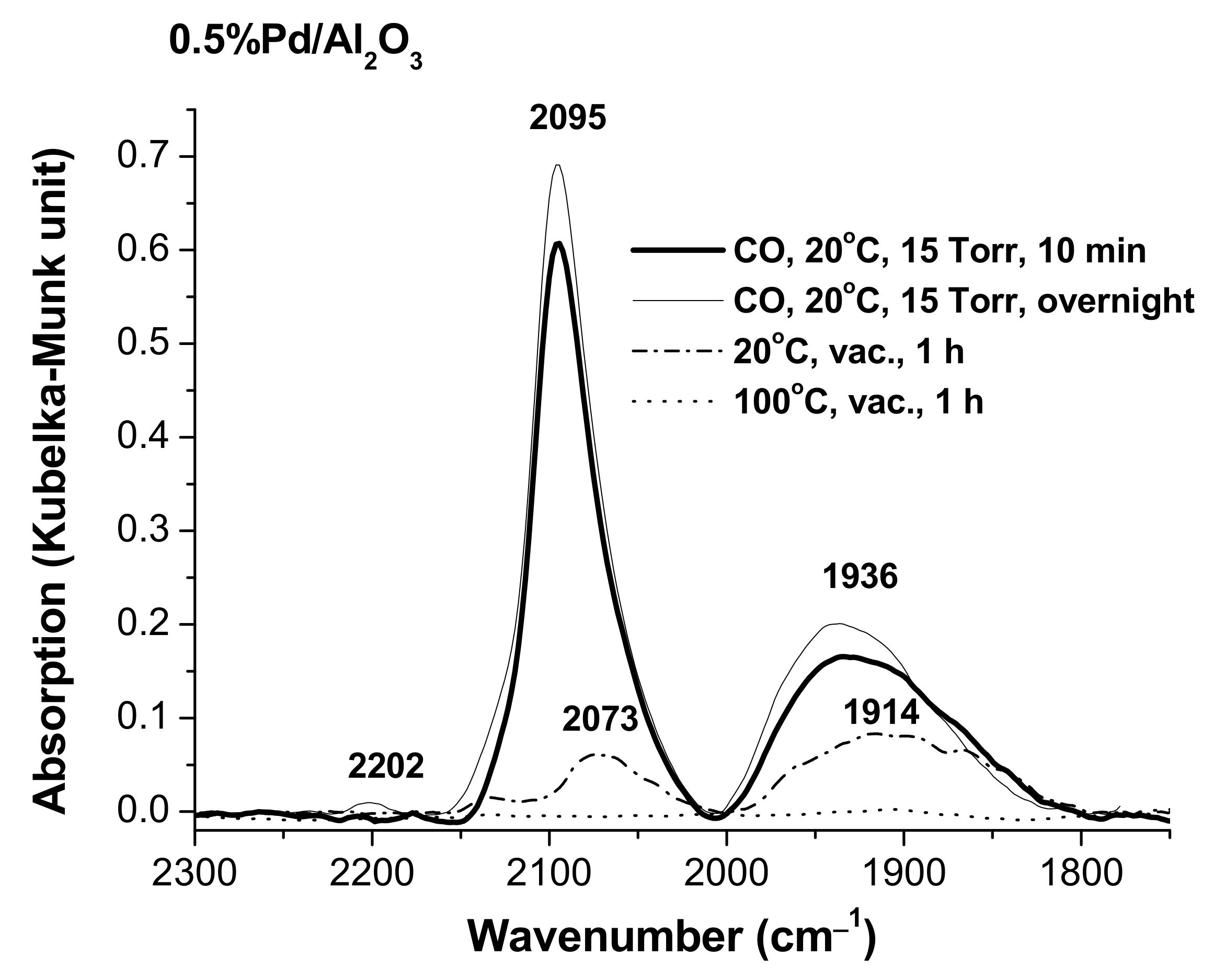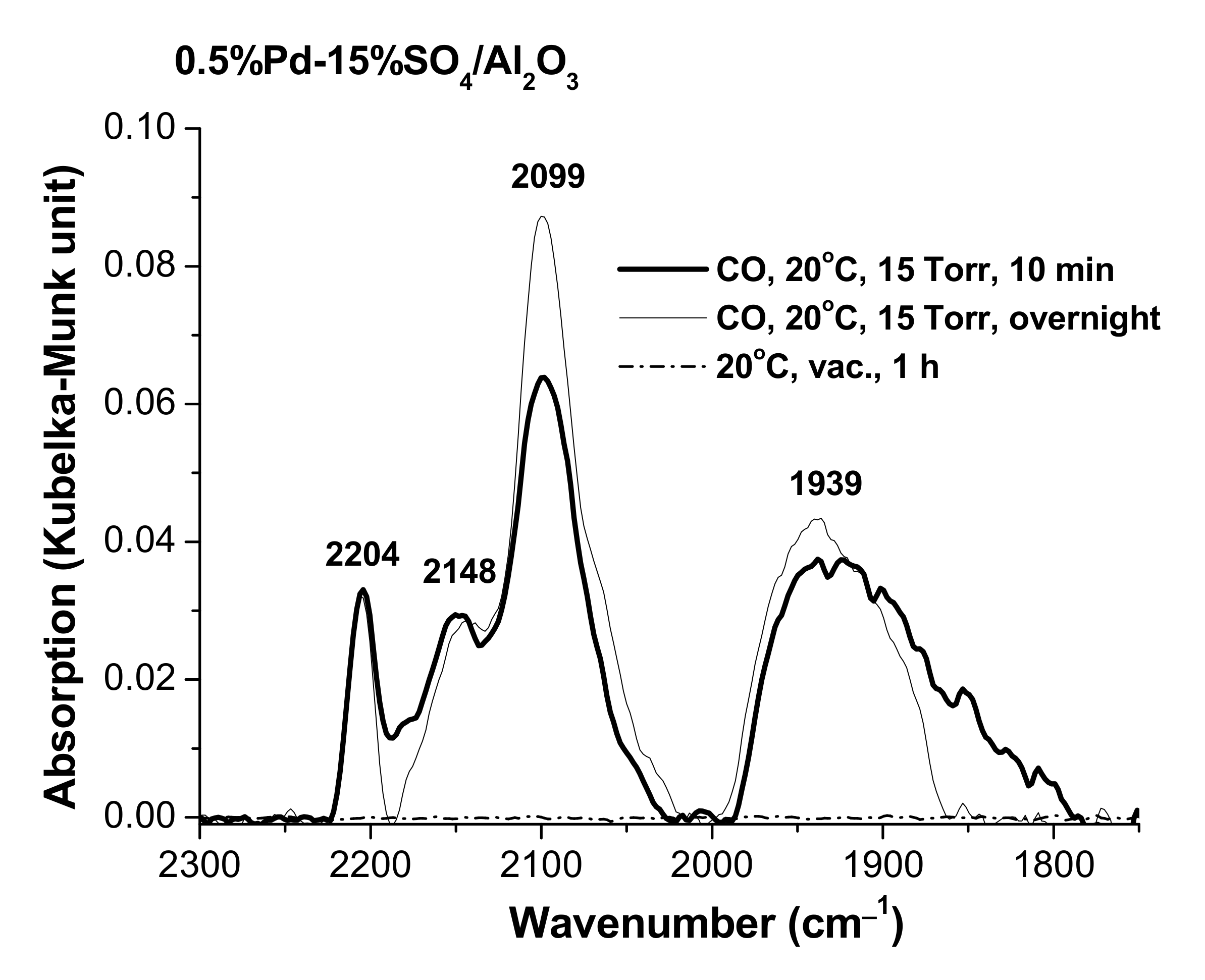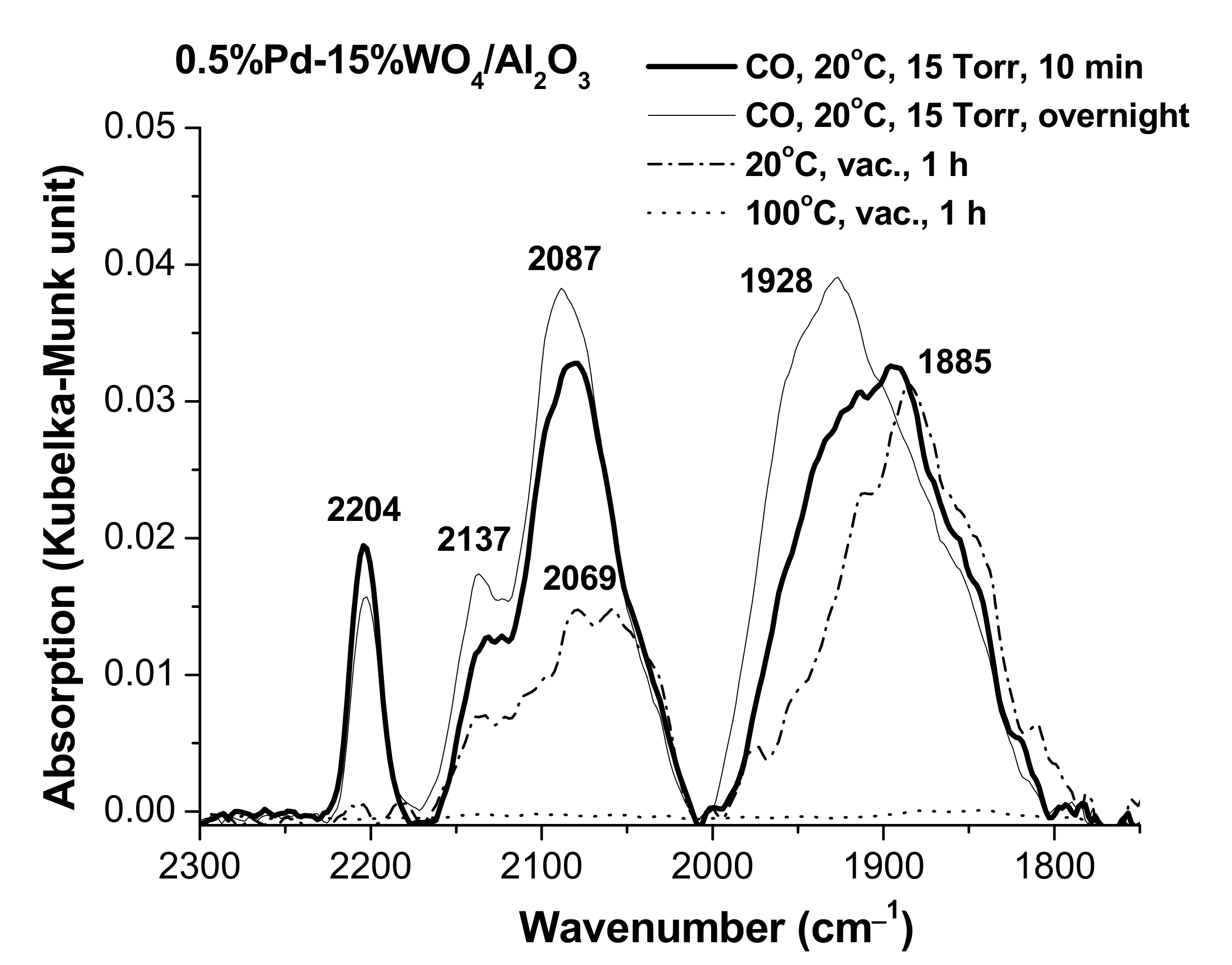Enhancement of Efficiency of Pd/Al2O3Catalysts in Selective Hydrogenation of Sec-Butylbenzene by Modification with H2SO4 or H2WO4
Abstract
:1. Introduction
2. Materials and Methods
2.1. Catalysts Preparation
2.2. Catalytic Measurements
2.3. Study of Catalysts by DRIFTS
3. Results
4. Conclusions
Author Contributions
Funding
Institutional Review Board Statement
Informed Consent Statement
Data Availability Statement
Conflicts of Interest
References
- Kumar, S.A.K.; John, M.; Pai, S.; Niwate, Y.; Newalkar, B.L. Low temperature hydrogenation of aromatics over Pt–Pd/SiO2–Al2O3 catalyst. Fuel Proc. Technol. 2014, 128, 303–309. [Google Scholar] [CrossRef]
- Wang, Y.; Cui, X.; Deng, Y.; Shi, F. Catalytic hydrogenation of aromatic rings catalyzed by Pd/NiO. RSC Adv. 2014, 4, 2729–2732. [Google Scholar] [CrossRef]
- Zahmakıran, M.; Tonbul, Y.; Ozkar, S. Ruthenium (0) nanoclusters stabilized by a nanozeolite framework: Isolable, reusable, and green catalyst for the hydrogenation of neat aromatics under mild conditions with the unprecedented catalytic activity and lifetime. J. Am. Chem. Soc. 2010, 132, 6541–6549. [Google Scholar] [CrossRef] [PubMed]
- Nie, R.; Jiang, H.; Lu, X.; Zhou, D.; Xia, Q. Highly active electron-deficient Pd clusters on N-doped active carbon for aromatic ring hydrogenation. Catal. Sci. Technol. 2016, 6, 1913–1920. [Google Scholar] [CrossRef]
- Lu, F.; Liu, J.; Xu, J. Fast aqueous/organic hydrogenation of arenes, olefins and carbonyl compounds by poly (N-Vinylpyrrolidone)-Ru as amphiphilic microreactor system. Adv. Synth. Catal. 2006, 348, 857–861. [Google Scholar] [CrossRef]
- Wege, V.; Kustov, L.M.; Tarasov, A.L. Catalyst, Useful for the Hydrogenation of Substituted Aromatic Compounds, Contains a Support Material Having a Specific Surface Area of Greater than 180 m2/g, 0.5–30 wt.% of an Anion Containing Modifier and 1–3 wt.% of a Group VIII Metal. DE Patent 10216748A1, 30 October 2003. [Google Scholar]
- Huyen, T.; Krivec, M.; Kocevar, M.; Bucur, I.C.; Rizescu, C.; Parvulescu, V.I. Hydrogenation of condensed aromatic compounds over mesoporous bifunctional catalysts following a diels–alder adduct pathway. ChemCatChem 2016, 8, 1146–1156. [Google Scholar] [CrossRef]
- Dokjampa, S.; Rirksomboon, T.; Osuwan, S.; Jongpatiwut, S.; Resasco, D.E. Comparative study of the hydrogenation of tetralin on supported Ni, Pt, and Pd catalysts. Catal. Today 2007, 123, 218–223. [Google Scholar] [CrossRef]
- Takasaki, M.; Motoyama, Y.; Higashi, K.; Yoon, S.; Mochida, I.; Nagashima, H. Ruthenium nanoparticles on nano-level-controlled carbon supports as highly effective catalysts for arene hydrogenation. Chem. Asian J. 2007, 2, 1524–1533. [Google Scholar] [CrossRef] [PubMed]
- Kustov, L.M. New trends in IR-spectroscopic characterization of acid and basic sites in zeolites and oxide catalysts. Top. Catal. 1995, 4, 131–144. [Google Scholar] [CrossRef]
- Borovkov, V.Y. The Nature and Properties of Acid-Base Centers of Amorphous Aluminosilicates, High-Silica Zeolites and Aluminum Oxides According to Diffuse-Reflectance IR Spectroscopy. Ph.D. Thesis, Institute of Organic Chemistry, Moscow, Russia, 1988; p. 454. [Google Scholar]
- Panov, A.G.; Ivanov, A.V.; Kustov, L.M.; Kazanskii, V.B. Study of acidic properties of TiO2 modified with SO42− ions. Kinet. Catal. 1997, 38, 432–436. [Google Scholar]
- Ivanov, A.V.; Kustov, L.M. Influence of support acidity on electronic state of platinum in oxide systems promoted by SO42− anions. Russ. Chem. Bull. 1998, 47, 1061–1066. [Google Scholar] [CrossRef]
- Davydov, A.A. Molecular Spectroscopy of Oxide Catalyst Surfaces; Wiley Publishing: Hoboken, NJ, USA, 2003; p. 466. [Google Scholar]
- Hadjiivanov, K.I.; Vayssilov, G.N. Characterization of oxide surfaces and zeolites by carbon monoxide as an IR probe molecule. Adv. Catal. 2002, 47, 307–501. [Google Scholar]
- Molnar, A.; Sarkany, A.; Varga, M.J. Hydrogenation of carbon–carbon multiple bonds: Chemo-, regio-and stereo-selectivity. Mol. Catal. A Chem. 2001, 173, 185–221. [Google Scholar] [CrossRef]
- Doyle, A.M.; Shaikhutdinov, S.K.; Freund, H.J. Alkene chemistry on the palladium surface: Nanoparticles vs single crystals. J. Catal. 2004, 223, 444–453. [Google Scholar] [CrossRef]
- Jongpatiwut, S.; Li, Z.; Resasco, D.E.; Alvarez, W.E.; Sughrue, E.L.; Dodwell, G.W. Competitive hydrogenation of poly-aromatic hydrocarbons on sulfur-resistant bimetallic Pt-Pd catalysts. Appl. Catal. A Gen. 2004, 262, 241–253. [Google Scholar] [CrossRef]
- Medin, A.S.; Borovkov, V.Y.; Kazansky, V.B.; Pelmentschikov, A.G. On the unusual mechanism of Lewis acidity manifestation in HZSM-5 zeolites. Zeolites 1990, 10, 668–673. [Google Scholar] [CrossRef]




| Catalyst | Specific Activity, gs-BB/gcat h | Specific Activity, Mole H2/gPd h |
|---|---|---|
| 0.5%Pd/Al2O3 | 3.5 | 15.6 |
| 0.5%Pd-4.5%SO4/Al2O3 | 4.8 | 21.3 |
| 0.5%Pd-9%SO4/Al2O3 | 5.95 | 26.6 |
| 0.5%Pd-15%WO4/Al2O3 | 6.05 | 27.0 |
| Al2O3 | 0 | - |
| 9%SO4/Al2O3 | 0.3 | - |
| 15%WO4/Al2O3 | 0.2 | - |
| Catalyst | Composition of Products, wt% | Conversion of s-BB, % | Selectivity for s-BCH, % | |||||
|---|---|---|---|---|---|---|---|---|
| C6 | C7 | C8 | C9 | s-BB | s-BCH | |||
| 0.5%Pd/Al2O3 | 0.2 | 4.8 | 7 | 12.9 | 49.6 | 25.5 | 50.4 | 50.6 |
| 0.5%Pd-4.5%SO4/Al2O3 | 0.1 | 0.4 | 2,1 | 0.5 | 12.5 | 84.4 | 87.5 | 96.5 |
| 0.5%Pd-9%SO4/Al2O3 | 0,2 | 0.9 | 3.4 | 0.9 | 3.5 | 91.1 | 96.5 | 94.4 |
| 0.5%Pd-15%WO4/Al2O3 | 0.4 | 1.4 | 4 | 5.6 | 0.2 | 88.4 | 99.8 | 88.6 |
| Al2O3 | nd | nd | nd | nd | nd | nd | 0 | nd |
| 9%SO4/Al2O3 | 79.4 | 17.2 | <2 | <2 | 97.7 | 0 | 2.3 | 0 |
| 15%WO4/Al2O3 | 82.6 | 15.5 | <1 | <1 | 98.6 | 0 | 1.4 | 0 |
Publisher’s Note: MDPI stays neutral with regard to jurisdictional claims in published maps and institutional affiliations. |
© 2021 by the authors. Licensee MDPI, Basel, Switzerland. This article is an open access article distributed under the terms and conditions of the Creative Commons Attribution (CC BY) license (http://creativecommons.org/licenses/by/4.0/).
Share and Cite
Kustov, L.M.; Tarasov, A.L.; Kustov, A.L.; Tkachenko, O.P. Enhancement of Efficiency of Pd/Al2O3Catalysts in Selective Hydrogenation of Sec-Butylbenzene by Modification with H2SO4 or H2WO4. Metals 2021, 11, 281. https://doi.org/10.3390/met11020281
Kustov LM, Tarasov AL, Kustov AL, Tkachenko OP. Enhancement of Efficiency of Pd/Al2O3Catalysts in Selective Hydrogenation of Sec-Butylbenzene by Modification with H2SO4 or H2WO4. Metals. 2021; 11(2):281. https://doi.org/10.3390/met11020281
Chicago/Turabian StyleKustov, Leonid M., Andrei L. Tarasov, Alexander L. Kustov, and Olga P. Tkachenko. 2021. "Enhancement of Efficiency of Pd/Al2O3Catalysts in Selective Hydrogenation of Sec-Butylbenzene by Modification with H2SO4 or H2WO4" Metals 11, no. 2: 281. https://doi.org/10.3390/met11020281
APA StyleKustov, L. M., Tarasov, A. L., Kustov, A. L., & Tkachenko, O. P. (2021). Enhancement of Efficiency of Pd/Al2O3Catalysts in Selective Hydrogenation of Sec-Butylbenzene by Modification with H2SO4 or H2WO4. Metals, 11(2), 281. https://doi.org/10.3390/met11020281







